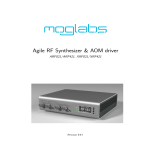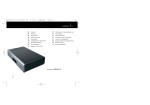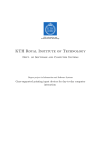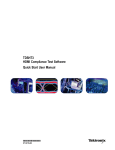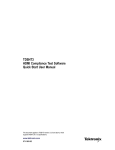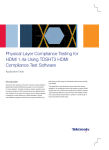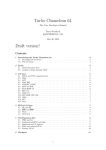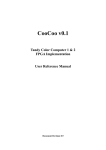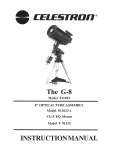Download Cateye OS 1.1 Specifications
Transcript
Cateye External Cavity Diode Laser Model CEL002 Revision 1.00 Limitation of Liability MOG Laboratories Pty Ltd (MOGLabs) does not assume any liability arising out of the use of the information contained within this manual. This document may contain or reference information and products protected by copyrights or patents and does not convey any license under the patent rights of MOGLabs, nor the rights of others. MOGLabs will not be liable for any defect in hardware or software or loss or inadequacy of data of any kind, or for any direct, indirect, incidental, or consequential damages in connection with or arising out of the performance or use of any of its products. The foregoing limitation of liability shall be equally applicable to any service provided by MOGLabs. Copyright c MOG Laboratories Pty Ltd (MOGLabs) 2006 – 2014. Copyright No part of this publication may be reproduced, stored in a retrieval system, or transmitted, in any form or by any means, electronic, mechanical, photocopying or otherwise, without the prior written permission of MOGLabs. Contact For further information, please contact: MOG Laboratories Pty Ltd 18 Boase St Brunswick VIC 3056 AUSTRALIA Tel: +61 3 9939 0677 Email: [email protected] Web: www.moglabs.com Preface Diode lasers can be wonderful things: they are efficient, compact, low cost, high power, low noise, tunable, and cover a large range of wavelengths. They can also be obstreperous, sensitive, and temperamental, particularly external cavity diode lasers (ECDLs). With external cavity feedback and advanced electronics such as the MOGLabs DLC external cavity diode laser controller, a simple $10 100 mW AlGaAs diode can become a research-quality narrow-linewidth tunable laser. The CEL “cateye” laser described here provides a robust, stable, acoustically inert, low linewidth and highly tunable laser alternative. We would like to thank the many people that have contributed their hard work, ideas, and inspiration, in particular Daniel Thompson, Sebastian Saliba and Michael Ventura. We hope that you enjoy using the MOGLabs CEL. Please let us know if you have any suggestions for improvement in the laser or in this document, so that we can make life in the laser lab easier for all, and check our website from time to time for updated information. MOGLabs, Melbourne, Australia www.moglabs.com i ii Safety Precautions Safe and effective use of this product is very important. Please read the following laser safety information before attempting to operate the laser. Also please note several specific and unusual cautionary notes before using MOGLabs lasers, in addition to the safety precautions that are standard for any electronic equipment or for laser-related instrumentation. CAUTION – USE OF CONTROLS OR ADJUSTMENTS OR PERFORMANCE OF PROCEDURES OTHER THAN THOSE SPECIFIED HEREIN MAY RESULT IN HAZARDOUS RADIATION EXPOSURE Laser output from the CEL can be dangerous. Please ensure that you implement the appropriate hazard minimisations for your environment, such as laser safety goggles, beam blocks, and door interlocks. MOGLabs takes no responsibility for safe configuration and use of the laser. Please: • Avoid direct exposure to the beam. • Avoid looking directly into the beam. • Note the safety labels (examples shown in figure below) and heed their warnings. • When the laser is switched on, there will be a short delay of two seconds before the emission of laser radiation, mandated by European laser safety regulations (IEC 60825-1). • The STANDBY/RUN keyswitch must be turned to RUN before the laser can be switched on. The laser will not operate if iii iv the keyswitch is in the STANDBY position. The key cannot be removed from the controller when it is in the clockwise (RUN) position. • To completely shut off power to the unit, turn the keyswitch anti-clockwise (STANDBY position), switch the mains power switch at rear of unit to OFF, and unplug the unit. • When the STANDBY/RUN keyswitch is on STANDBY, there cannot be power to the laser diode, but power is still being supplied to the laser head for temperature control. WARNING The internal circuit board and piezoelectric transducers are at high voltage during operation. The unit should not be operated with covers removed. CAUTION Although the CEL is designed and priced with the expectation that the end-user can replace the diode and change the alignment, some components are fragile. In particular the filter, piezo actuator, and output coupler are very easily damaged. Please take care of these items when working inside the laser. The filter and output coupler are hard-coated and can be cleaned but great care is needed as with any intracavity laser optics. NOTE MOGLabs products are designed for use in scientific research laboratories. They should not be used for consumer or medical applications. Label identification The International Electrotechnical Commission laser safety standard IEC 60825-1:2007 mandates warning labels that provide information on the wavelength and power of emitted laser radiation, and which show the aperture where laser radiation is emitted. Figures 1 and 2 shows examples of these labels and their location on the CEL laser. v M S o Ma eriadl el nu nu nu m fac m be ture ber: r: d: Co de mpli M viatio es Bru OG ns puwith 21 E rsu CF ns La an A CD R wic bo k V rato t to La 1040.10 JU 220 -00 IC rie ser No , an LY 33 0 3 30 s P 56 ty tice Nod 1040 201 211 , A Ltd, 02-0 .50 .11 1 US , ex 1 TR 18 B dated cept ALI oa 24 Ju for ne A se 2007 St Model number: ECD-004 Serial number: A42034011208-01 Manufactured: JULY 2012 Complies with 21 CFR 1040.10, and 1040.11 except for deviations pursuant to Laser Notice No.50, dated 24 June 2007 MOG Laboratories Pty Ltd, 18 Boase St Brunswick VIC 3056, AUSTRALIA INVISIB LE AVOID LASER RADIA EXP TIO CLASS OSURE TO BEA N 3B LAS ER PRO M DUCT Waveleng th 770 – 795 nm Emission indicator Max Pow er 100 mW IEC 6082 AS/NZS 5-1:2007 2211.5:20 06 INVISIBLE LASER RADIATION AVOID EXPOSURE TO BEAM CLASS 3B LASER PRODUCT Wavelength 770 – 795 nm Max Power 100 mW IEC 60825-1:2007 AS/NZS 2211.5:2006 Figure 1: Schematic showing location of laser warning labels compliant with International Electrotechnical Commission standard IEC 608251:2007, and US FDA compliance label. Aperture label engraved on the front of the CEL laser near the exit aperture; warning advisory label on the rear and compliance label beneath. vi Model number: ECD-004 Serial number: A42034011208-01 Manufactured: JULY 2012 Complies with 21 CFR 1040.10, and 1040.11 except for deviations pursuant to Laser Notice No.50, dated 24 June 2007 US FDA compliance MOG Laboratories Pty Ltd, 18 Boase St Brunswick VIC 3056, AUSTRALIA AVOID EXPOSURE VISIBLE AND INVISIBLE LASER RADIATION IS EMITTED FROM THIS APERTURE INVISIBLE LASER RADIATION AVOID EXPOSURE TO BEAM CLASS 3B LASER PRODUCT Wavelength 770 – 795 nm Max Power 100 mW Warning and advisory label Class 3B IEC 60825-1:2007 AS/NZS 2211.5:2006 INVISIBLE LASER RADIATION AVOID EYE OR SKIN EXPOSURE TO DIRECT OR SCATTERED RADIATION CLASS 4 LASER PRODUCT Wavelength 770 – 795 nm Max Power 150 mW Aperture label engraving Warning and advisory label Class 4 IEC 60825-1:2007 AS/NZS 2211.5:2006 Figure 2: Warning advisory and US FDA compliance labels. Protection Features MOGLabs lasers includes a number of features to protect you and your laser. Protection relay When the power is off, or if the laser is off, the laser diode is shorted via a normally-closed solid-state relay at the laser head board. Emission indicator The MOGLabs controller will illuminate the emission warning indicator LED immediately when the laser is switched on. There will then be a delay of at least 2 seconds before actual laser emission. Interlock It is assumed that the laser power supply is keyed and interlocked for safety. The laser head board also provides connection for an interlock (see appendix B), if used with a power supply which does not include such an interlock. vii RoHS Certification of Conformance MOG Laboratories Pty Ltd certifies that the MOGLabs External Cavity Diode Laser does not fall under the scope defined in RoHS Directive 2002/95/EC, and is not subject to compliance, in accordance with DIRECTIVE 2002/95/EC Out of Scope; Electronics related; Intended application is for Monitoring and Control or Medical Instrumentation. MOG Laboratories Pty Ltd makes no claims or inferences of the compliance status of its products if used other than for their intended purpose. viii Contents Preface i Safety iii Protection Features vii RoHS Certification of Conformance viii 1 Introduction 1.1 External cavity . . . . . . . . . . 1.2 Mode competition . . . . . . . . . 1.3 Piezo-electric frequency control 1.4 Temperature and current . . . . . . . . . 1 2 3 3 4 2 First light 2.1 Temperature . . . . . . . . . . . . . . . . . . . . . . . . 2.2 Current . . . . . . . . . . . . . . . . . . . . . . . . . . . 5 6 7 . . . . . . . . . . . . . . . . . . . . . . . . . . . . . . . . . . . . 3 Alignment 3.1 Pre-alignment of lens tube and diode . . . . . . 3.2 Initial diode test . . . . . . . . . . . . . . . . . . 3.3 Orientation and polarisation of the output beam 3.4 Cateye reflector . . . . . . . . . . . . . . . . . . . . . . . . . . . . . . . 9 9 11 11 12 4 Operation 4.1 Wavelength . . . . . . . . . . . . . . . . . . . . . . . . 4.2 Scanning . . . . . . . . . . . . . . . . . . . . . . . . . . 4.3 External modulation . . . . . . . . . . . . . . . . . . . 15 15 16 18 A Specifications A.1 RF response . . . . . . . . . . . . . . . . . . . . . . . . 19 21 ix . . . . . . . . Contents x B Connector pinouts B.1 Headboard . . . . . . . . . . . . . . . . . . . . . . . . . B.2 Laser . . . . . . . . . . . . . . . . . . . . . . . . . . . . B.3 RF coupling . . . . . . . . . . . . . . . . . . . . . . . . 23 23 25 25 References 28 1. Introduction Semiconductor laser diodes are compact, efficient and low-cost, but usually have poor wavelength control, linewidth and stability. The addition of an external frequency-selective cavity allows control of the operating wavelength over a few nm range, with sub-MHz linewidth and stability. The MOGLabs CEL (see Fig. 1.1) is machined from a solid aluminium block, so that the laser is stable, robust, and insensitive to acoustic disturbances. The cavity is hermetically sealed for additional suppression of environmental fluctuations and drift. The MOGLabs CEL is a “cat-eye” design (see Fig. 1.2), in which an external cavity is formed between the rear reflecting surface of the semiconductor diode, and a cat-eye reflector at several centimetres from the diode [1–3]. Rather than the customary diffraction grating of Littrow-configuration ECDLs, a high efficiency ultranarrow filter Figure 1.1: Inside the MOGLabs CEL cateye laser. 1 Chapter 1. Introduction 2 is used to select a single external cavity mode. Without the need for illuminating a large area of a grating for feedback, a cat-eye retroreflector and partially transmitting output coupler can be used to form the external cavity. The cateye reflector is inherently selfaligning, so that the laser is extremely insensitive to mechanical disturbance, and also ensures high feedback coupling efficiency and consequently narrow linewidth. PZT LENS DIODE FILTER LENS OC LENS Figure 1.2: Schematic of a cateye external cavity diode laser (ECDL). The external cavity, formed by the rear facet of the laser diode and the output coupler, determines the laser frequency. One longitudinal cavity mode is selected by an ultranarrow intracavity bandpass filter. A cateye reflector is formed by the output coupler (OC) and intracavity lens, and the light is recollimated by the extracavity output lens. The output beam from a laser diode is collimated with a high numerical aperture (NA) lens and incident on the filter. The filter transmission wavelength depends on the rotation angle. Transmitted light is back-reflected by the cateye lens/output-coupler combination which efficiently couples light back into the laser diode. More details can be found in the references [1–3]. 1.1 External cavity Semiconductor laser diodes normally have a high reflectivity rear facet and a front facet with reflectivity of only a few percent. The diode cavity is called the intrinsic or internal cavity. The external cavity is formed by the cateye and the diode rear facet, and when the external feedback is greater than that of the front facet, the ex- 1.2 Mode competition 3 ternal cavity determines the lasing wavelength. The external cavity is typically around 40 mm long from rear facet of semiconductor to output coupler, giving a cavity mode spacing (FSR) of c/2L = 3 to 4 GHz. The laser diode and collimating lens are held rigidly in a focusing tube. The filter is fixed to a bearing-mounted rotation assembly with fine actuator screws to adjust the angle. The spring-loaded screws operate in a push-pull arrangement which can be locked against each other to further reduce the effects of mechanical vibration. Variation of the filter angle is used for coarse selection of the wavelength, within the gain bandwidth of the laser diode. 1.2 Mode competition As the wavelength is varied, competition between the frequency determined by the internal and external cavities, and the filter transmission window, leads to mode hops. From figure 1.3 it can be seen that the net gain (combined product of semiconductor gain, filter loss, internal and external cavity interference) can be very similar at adjacent external cavity modes. A small change in the internal cavity mode, or the filter angle, can lead to the overall gain being greater at a mode adjacent to the mode in which the laser is oscillating, and the laser then hops to that higher-gain mode. See Ref. [4] for a detailed discussion. 1.3 Piezo-electric frequency control Small changes to the laser frequency are achieved by controlling the external cavity length with a piezo electric actuator. For the MOGLabs CEL, the output coupler is mounted to a multilayer piezoelectric “stack”. The cavity length variation is of order 10 nm per volt, producing a frequency shift of 70 MHz/V with a range of 10 GHz for 150 V drive voltage. The bandwidth is limited by mechanical resonances, typically 25 kHz. Chapter 1. Introduction 4 Diode cavity Diode gain External cavity Filter COMBINED 384.0 384.1 384.2 Frequency (THz) 384.3 384.4 Figure 1.3: Schematic representation for the various frequency-dependent factors of an ECDL, adapted from Ref. [4], for wavelength λ = 780 nm and external cavity length Lext = 15 mm. 1.4 Temperature and current The laser frequency is also dependent on temperature and injection current; the sensitivities are typically 3 MHz/µA and 30 GHz/K [5]. Thus, low-noise stable electronics, such as the MOGLabs DLC external cavity diode laser controller, are essential (see Ref. [6]) to achieve sub-MHz linewidth and stability. A critical aspect of an ECDL is temperature control of the cavity, since the laser frequency depends on the cavity length and hence on the thermal expansion coefficient of the cavity material [4]. The cavity can be machined from materials with low thermal expansion coefficient but even then the passive stability is inadequate for research applications. Active feedback of the cavity temperature combined with cavity length control provide a flexible and stable approach. The MOGLabs CEL uses a negative temperature coefficient (NTC) thermistor to sense the cavity temperature and Peltier thermoelectric cooler (TEC) to heat and cool the cavity material. 2. First light Initial installation of the laser is typically a matter of mounting it to an optical table and connecting to a MOGLabs controller. The laser can be mounted to posts using the M3 threaded holes on the base, or by removing the cover and screwing directly to the optical table using the M6x25 socket head cap screws provided. The hole spacing also allows direct mounting to imperial tables for non-metric countries (Burma, Liberia and the USA). The laser includes a water cooling channel for laser operation at unusually high or low temperatures, or in laboratories with high or unstable air temperature. For most applications, water cooling is not required; dissipation to the air and/or optical table is sufficient. The performance of an external cavity diode laser is strongly dependent on the external environment, and in particular acoustic vibrations. Very small changes in the external cavity length have a large effect on the laser frequency, typically 25 MHz per nanometre length change. The monolithic block construction of the MOGLabs CEL reduces the influence of vibrations on the cavity length, but some elasticity remains. Acoustic disturbances in the air gap also affect the frequency. Active feedback to the laser frequency reduces these influences, but some simple measures to minimise coupling to environmental variations and vibration sources may be warranted. For example, a surrounding box to reduce air movement and accidental bumping of the laser; mounting the laser to a heavy support, and isolation from the optical table with an intermediary breadboard which is separated from the main optical table with viscoelastic polymer (e.g. SorbothaneTM ). Once the laser is mounted appropriately, the laser can be switched on. Please refer to the supplied test data for nominal temperature and current settings, and in particular be aware of the maximum current limit. 5 Chapter 2. First light 6 It is assumed that a MOGLabs DLC controller will be used to drive the laser. If an alternative supply is used, note that +5 V must be provided on pin 15 of the headboard connector to open the protective relay. See section B.1 for connection details. Also please refer to the laser test data for the maximum safe operating current. 2.1 Temperature The preferred diode temperature will depend on the diode, the required wavelength, and the ambient room temperature. For example, typical AlGaAs diodes used for data storage applications (CD-R burners) have a nominal wavelength of λ = 784 nm at 25◦ C, with a dλ/dT slope of −0.3 nm/ ◦ C, implying an optimum temperature of about 12◦ . Depending on the humidity, low temperatures may induce condensation on the diode and collimation lens. The filter will determine the final wavelength, and the feedback is generally sufficient to “pull” the wavelength by ±5 nm, and thus in this example a sensible set temperature would be about 17 to 18◦ C. 2.2 Current Current The output of semiconductor laser diodes follow a nominally linear power vs. current relationship, once the current is above a devicespecific threshold (see Fig. 2.1). Initially the current should be set above threshold, but well below the nominal maximum operating current, until the laser is fully aligned. 140 Bare 150mW diode 780.243nm Extracavity estimate 120 Power (mW) 2.2 7 100 80 60 40 20 0 0 20 40 60 80 100 120 Injection current (mA) 140 160 180 200 Figure 2.1: Sample laser diode power-current characteristic curves, with and without an external cavity. The output for a diode with good antireflection coating is negligible. The steps show that for higher currents, some of the light from the diode is not transmitted by the filter, typically because the external cavity mode frequency is not perfectly aligned with the filter transmission frequency. 8 Chapter 2. First light 3. Alignment The cateye reflector arrangement is self-aligning, and should not require adjustment. However, laser diodes have a finite lifetime, and diode replacement may necessitate alignment of the internal optics, in particular the diode collimation and cateye lenses. For longer wavelength lasers, an infra-red upconversion card or CCD camera can be very helpful. Common low-cost security cameras, computer USB cameras, and home movie or still cameras are also good options, although they often have infra red filters which may need to be removed. Diodes are very sensitive to electrostatic discharge. Please make sure you are electrically grounded, ideally with a wrist ground strap. If you do not have a proper wrist ground strap, at least be sure you are not wearing woolen clothing, and touch something grounded from time to time (e.g. a soldering iron tip, the earth of a power supply, the MOGLabs DLC controller). 3.1 Pre-alignment of lens tube and diode 1. Insert the laser diode into the lens tube (see Fig. 3.1). If using a lens tube with alignment screws, ensure that the V-notch in the diode is aligned with one of the alignment screws. 2. Add the retaining threaded ring, and tighten gently, just enough such that the diode does not move. 3. If using a lens tube with alignment adjustment screws, use the 5.6 mm retaining ring even for 9 mm diodes. 4. Approximately centre the diode using the alignment adjustment screws and two 0.9 mm hex keys. 5. Insert the collimation lens, taking care to ensure that the lens 9 Chapter 3. Alignment 10 Lens Retaining ring 5.6mm diode 9mm diode Figure 3.1: Lens tube assembly, showing diode, lens, and mounting hardware. The same tube can be used for 5.6 mm and 9 mm diodes. Note that your lens tube may have alignment adjustment screws. Figure 3.2: Image showing collimation tubes. does not contact the diode. Also ensure the lens is tight; if not, use PTFE tape on the lens threads. Two layers of thick tape (90 µm as used for gas plumbing) is good. 6. Mount the lens tube in a holder or mount that allows rotation of the entire assembly around the long axis. 7. Apply power to the diode, above threshold but well below the maximum permissible current. 8. Approximately focus at several metres distance. It may be helpful to reflect it from a mirror and back so that you can adjust the alignment and see the effect nearby. You should adjust focus until you see a clean symmetric ellipse at this 3.2 Initial diode test 11 distance. 9. Rotate the collimation assembly and adjust the alignment screws until the beam remains reasonably well on-axis. 10. Tighten the retaining ring (hard) and re-check that the diode remains aligned. 11. Focus the collimation lens such that the laser focuses to a spot at some significant distance, more than 4m. The laser stability and modehop free range can be better if the laser output is weakly converging [6]. 3.2 Initial diode test 1. Inspect the beam profile for diffraction fringes. If the lens has been screwed in too far and made contact with the diode (particularly for 5.6 mm diodes), the lens can become scratched or stressed, leading to poor performance. Fringes can be an indication of such scratches (or an indication of a poor diode). 2. On the MOGLabs DLC controller, make sure DIP switch 4 (Bias) is OFF, the span is set to zero (fully anti-clockwise), and the frequency knob is at zero (middle of range; set the display selector to Frequency and adjust to zero volts). 3. Measure the power/current (LI) curve for the bare collimated diode. This provides a useful benchmark for comparison when optimising the threshold lowering with feedback. 3.3 Orientation and polarisation of the output beam The output from the diode is a widely diverging elliptical beam, normally TE polarised; that is, with polarisation parallel to the short (minor) axis of the ellipse. The filter performance is typically better in p-polarisation; that is, with polarisation in the plane of reflection Chapter 3. Alignment 12 Filter E From diode θ Figure 3.3: Orientation of the diode laser beam ellipse with respect to the filter rotation, for TE polarised diode, oriented with p-plane polarisation. from the filter. In that case, for the MOGLabs CEL, the polarisation should be horizontal and the ellipse should be with long axis vertical. Some diodes, particularly around 750 to 820 nm, are TM polarised, with polarisation parallel to the long axis of the ellipse. For these diodes, the ellipse should be horizontal. The filter dependence on polarisation is weak and in most cases any rotation of the diode will work acceptably well. 3.4 Cateye reflector Light reflected from a cateye lens/mirror combination will be parallel to the incident radiation, regardless of the incident angle. Thus the cateye reflector is self-aligning: the light is always reflected back to the diode, even if the beam is not well collimated. The effect relies on the lens-mirror distance matching the focal length of the lens. There are several methods for achieving optimum focus; probably the easiest is to adjust the focus so as to minimise the lasing threshold. Mount the diode collimation lens tube and cateye reflector assem- 3.4 Cateye reflector 13 35mm Lens tube Cateye Recollimator Figure 3.4: Arrangement of lens tube and cateye reflector for adjustment of focus of cateye. bly at about 35 mm apart, without filter (see Fig. 3.4). Set the diode current just below threshold, and then adjust the cateye lens focus until the output suddenly flashes brightly, indicating effective feedback which tends to lower the overall ECDL gain threshold. Repeat until the minimum is obtained. The sequence is as follows: 1. Mount the lens tube and cateye reflector about 35 mm apart. 2. Monitor the output beam on a piece of black card at a short distance from the cateye assembly. It is helpful to recollimate the output after the cateye; any lens can be used, at approximately the focal length of that lens from the output coupler. Monitor the beam spot using a security camera or webcam. 3. Adjust the injection current to just below threshold. 4. Adjust the cateye lens focus until a bright flash (i.e. lasing) is observed. 5. Iterate reduction of the injection current, following by focus of the cateye, until the minimum threshold is achieved. 6. Reassemble the laser and adjust the filter angle to achieve the desired wavelength. 14 Chapter 3. Alignment 7. If possible, scan the laser through an atomic resonance and view the absorption on an oscilloscope. With current bias disabled (DIP 4 on a MOGLabs controller) and full span, you should see a reasonable fraction of the absorption spectrum, with one or more mode-hops. A Fabry-Perot etalon or a fast high-resolution wavemeter (MOGLabs MWM) can also be used to optimise the mode-hop-free range. 8. Adjust the filter angle, and the injection current, to optimise the scans so that you see the maximum number of repeats and the deepest signals. 9. Check that the saturated absorption traces are clean. Noisy spectra indicate multi-mode operation, or high linewidth, which may be due to weak feedback. The lasing threshold is a good diagnostic: lower threshold indicates better feedback and consequently lower linewidth. A scanning Fabry-Perot or a MOGLabs MWM wavemeter is a very useful diagnostic tool to check for single-mode operation. 10. Measure the laser output power as a function of diode injection current, and plot the power/current response as in Fig. 2.1. Compare against the original data provided with your laser and if concerned about discrepancies, contact MOGLabs. 11. Switch the current bias (DIP switch 4) back on, and adjust the bias to optimise the mode-hop-free scan range. The laser should now be operating with mode-selected feedback near the desired wavelength of the diode. The threshold current should be significantly lower than without feedback (2 to 5 mA for standard 780 nm diodes). Record the output power and threshold characteristics for subsequent reference. 4. Operation Normal operation of the laser is usually a matter of adjusting the filter rotation angle to select the correct wavelength, and adjusting the piezo offset, diode injection current and bias to achieve the maximum possible mode-hop free scan. 4.1 Wavelength The primary control of wavelength is the filter rotation angle, which can be adjusted while the laser is operational. A wavemeter [7], high-resolution spectrometer, or similar is almost essential, although with patience it is possible to find an atomic reference by carefully adjusting the filter angle while scanning the laser. The filter transmission wavelength shifts with rotation according to s sin(θ) 2 λ(θ) = λ0 1 − (4.1.1) neff where θ is the angle of incidence, λ0 is the filter wavelength at normal incidence and neff = 2.13 for p-polarization. The sensitivity to rotation of the fine tangential wavelength adjustment screw (labelled λ in figure) is about 0.5 nm per turn. Set the laser current so that the output power is sufficient, taking care to ensure that the internal cavity power is below the maximum rated for the diode (see Fig. 2.1). Then change the filter angle to adjust the wavelength. The laser will hop between external cavity modes, as the wavelength is adjusted, through cycles of dim and bright output. Adjust the angle to one of the bright modes nearest the optimum wavelength, and then adjust the laser current and the piezo voltage to achieve the exact wavelength required. 15 Chapter 4. Operation 16 Figure 4.1: Sketch of the MOGLabs CEL, showing the filter rotation adjustment screw, labelled λ. 4.2 Scanning The external cavity length is controlled by piezo actuators moving the output coupler. The cavity length increases with increasing voltage on the piezos, thus decreasing the laser frequency. For a large frequency change, the laser will usually hop to a neighbouring cavity mode (see Fig. 4.2). The continuous scan range (free of mode hops) can be optimised by careful adjustment of the injection current, which affects the refractive index of the diode semiconductor and hence the frequency of the cavity mode. This shift of cavity mode frequency allows for compensation of the mismatch of tuning responses. The diode injection current can be 4.2 Scanning 17 Relative Gain 1 0 -200 -100 0 100 200 Frequency (GHz) Figure 4.2: Combined gain for an external cavity diode laser, including the internal and external modes, the diode laser gain, and the filter absorption. The predominant feature is the frequency selectivity of the filter, and the smaller peaks are the external cavity modes (see Fig. 1.3). A small relative shift of the external cavity mode relative to the filter frequency will cause the laser to jump to another external cavity mode where the net gain is higher. “automatically” adjusted as the laser frequency is changed, using a “feed-forward” or current bias which changes as the piezo voltage is changed. Feed-forward current bias adjustment is a feature of MOGLabs DLC controllers. Adjustment is straightforward. The laser frequency is scanned (with a downward ramp voltage to the piezo), and the current bias control is adjusted so that the current is also ramping downward, until the maximum mode-hop-free scan range is observed. Small changes to the injection current optimise the scan range near the nominal centre frequency. Chapter 4. Operation 18 4.3 External modulation The laser diode injection current can be modulated directly, or via the SMA RF input on the laser headboard (see section B.3). The combined modulation bandwidth extends from DC to about 2.5 GHz, provided the standard connection from headboard to diode is replaced with a suitable coaxial cable. Even higher frequencies can be used with addition of an appropriate microwave bias-tee such as the Minicircuits ZFBT-6G+, between the laser headboard and the diode. Direct modulation is commonly used for frequency stabilisation, e.g. the frequency modulation sideband method [8, 9], Pound-DreverHall [10], and also for offset locking schemes [11, 12]. Microwave modulation is often used for two-frequency pumping of alkali atoms, for example to access both a laser cooling transition and a repump to prevent trapping in dark states [4, 13, 14]. The modulation efficiency can be enhanced by matching the external cavity length to the modulation frequency. That is, set the cavity length L = c/2Ω where Ω is the modulation frequency. The cavity length can be adjusted slightly by sliding the collimation tube in the monolithic block. For example, to access the 87 Rb hyperfine ground states, separated by 6.8 GHz, the cavity length could be 2.2 cm and the modulation at 6.8 GHz, or 4.4 cm with modulation at 3.4 GHz so that the two sidebands are used and the carrier is off-resonant. A. Specifications Parameter Specification Wavelength/frequency 50 mW standard. Up to 150 mW output 780 nm power available. Please contact MOGLabs for availability. 369.5 – 1120 nm Linewidth Typically < 150 kHz RF modulation 160 kHz – 2.5 GHz Filter 0.3 nm bandpass Tuning range Typically 10 nm for single diode Sweep/scan Scan range 10 GHz Mode-hop free 10 GHz Piezo stack 3 µm @ 150 V, 50 nF Cavity length 35 mm Optical Beam 3 mm × 1 mm (1/e2 ) typical Polarisation Vertical linear 100:1 typical (can be rotated) 19 Appendix A. Specifications 20 Parameter Specification Thermal TEC ±14.5 V 3.3 A Q = 23 W standard Sensor NTC 10 kΩ standard; AD590, 592 optional Stability at base ±1 mK (controller dependent) Cooling Optional: 4 mm diam quick-fit water cooling connections Electronics Indicator Diode short-circuit relay; cover interlock connection; reverse diode Laser ON/OFF (LED) input 160 kHz – 2.5 GHz bias tee, to DC optional Protection RF Connector MOGLabs Diode Laser Controller single ca- ble connect Mechanical & power Dimensions 108 × 70 × 83 mm (L×W×H), 1 kg Beam height 54.5 mm Shipping 420 × 360 × 260 mm (L×W×H), 3.1 kg A.1 RF response A.1 RF 21 response The laser includes an RF bias tee, with typical frequency response shown below. By default, the connection to the laser diode does not provide the full bandwidth of the bias tee. A small circuit board, for RF connection to the diode, is available from MOGLabs; please contact us for further details if required. Ref -20 dBm TG * Att -30 dBm 50 dB * RBW 30 kHz * VBW 10 MHz SWT 17 s -20 -25 -30 -35 -40 -45 -50 -55 -60 -65 -70 Center 1.5 GHz 300 MHz/ Span 3 GHz Figure A.1: RF response, SMA input on laser headboard to diode SMA output. 22 Appendix A. Specifications B. Connector pinouts B.1 Headboard The laser head interface board provides connection breakout to the laser diode, TEC, sensor, piezo actuators, and laser head interlock. It also includes a solid-state protection relay and passive protection filters, a laser-on LED indicator, and an SMA connection for direct diode current modulation. The connections are made with Hirose DF59 “swing-lock” wire-to-board connectors. For high bandwidth RF modulation the diode should be directly soldered to a special interconnect assembly available from MOGLabs. No provision is made for optical power control or measurement for diodes that have an internal photodiode. Figure B.1: MOGLabs CEL laser head board showing connectors for laser diode, piezo actuator, temperature sensors, TEC and head enclosure interlock. 23 Chassis Earth Mount Hole Single 5 Single 6 Single 3 Single 4 Single 1 Single 2 Pair 6 Pair 6 P6 Shield P0/5 Shield Pair 5 Pair 5 Pair 0 Pair 0 P1/3 Shield Pair 3 Pair 3 Pair 1 Pair 1 P2/4 Shield Pair 4 Pair 4 Pair 2 Pair 2 Laser Laser + 14 15 Relay Relay + 4k99 R2 Active sensor Active sensor + 6 7 8 16 Shield Thermistor + Thermistor Shield Stack Piezo + Stack Piezo - 20 21 19 Disc Piezo + Disc Piezo - 17 18 24 23 22 Shield 11 12 13 Shield 3 Peltier Peltier + 9 10 4 5 1 2 P5v RF Laser Current Input Female SMA Sig 4 3 2 1 R1 390R P5v R5 499R U1B U1A SMA - 5P Gnd P1 P5v NC NC 2 1 5 6 7 8 HD4 R3 10k0 C4 D2 Flying leads P5v 250V 10nF DNI Laser Interlock Lid posiiton interlock Voltage Free contact that closes when box in posiiton LED 100uH L1 43R R4 D1 3 2 1 SMA - 5P Gnd Sig P3 HD1 Laser RF high bandwidth connection to diode Gnd 24 Appendix B. Connector pinouts Figure B.2: CEL headboard schematic. The RF modulation low-pass cutoff frequency is determined by C4 and the diode impedance (∼ 50Ω). B.2 Laser B.2 25 Laser WARNING: The LASER connector is a standard DVI-D Dual Link socket as used for consumer digital display devices. It should only be connected to the corresponding MOGLabs DLC controller. It supplies the high-voltage signals to drive the laser piezoelectric actuators. The piezo drivers will be disabled if the cable is disconnected, but nevertheless considerable care should be taken to ensure that nonMOGLabs devices are not connected via this connector. The MOGLabs cable can be replaced with a standard digital DVI-D Dual cable. There is a bewildering assortment of apparently similar cables available; only high quality dual-link digital DVI-D cables should be used. Pin 1 2 3 4 5 6 7 8 Signal TEC – TEC + Shield TEC – TEC + AD590/592 – AD590/592 + Pin 9 10 11 12 13 14 15 16 Signal DIODE – DIODE + Shield DIODE – DIODE + Relay GND Relay +5V Interlock +5V 1 8 17 24 Pin 17 18 19 20 21 22 23 24 Signal DISC + DISC – Shield STACK + STACK – NTC – NTC + Figure B.3: LASER connector on rear panel. B.3 RF coupling The SMA connector on the laser head board allows high-frequency current modulation. The RF input is AC coupled, with low- and highfrequency limits of about 160 kHz and 2.5 GHz (see Fig. A.1). Capacitor C4, normally 10 pF, can be changed to adjust the low-frequency 26 Appendix B. Connector pinouts cutoff. For higher bandwidths, use an external bias-tee such as the Minicircuits ZFBT-6G+ between the head board and the diode. The input sensitivity depends on the diode impedance, typically about 50 Ω. Thus a 0 dBm signal corresponds to about 0.2 V and a current of around 4 mA at the diode. That is, the current sensitivity is approximately 20 mA/V. WARNING: The RF input is a direct connection to the laser diode. Excessive power can destroy the diode. It is separated from the head board relay by an inductor, and thus the relay does not provide protection from high frequency signals. Bibliography [1] Daniel J. Thompson and Robert E. Scholten. Narrow linewidth tunable external cavity diode laser using wide bandwidth filter. Review of Scientific Instruments, 83(2):–, 2012. 1, 2 [2] X. Baillard, A. Gauguet, S. Bize, P. Lemonde, Ph. Laurent, A. Clairon, and P. Rosenbusch. Interference-filter-stabilized external-cavity diode lasers. Opt. Communic., 266:609, 2006. 1, 2 [3] M. Gilowski, Ch. Schubert, M. Zaiser, W. Herr, T. WÃijbbena, T. Wendrich, T. MÃijller, E.M. Rasel, and W. Ertmer. Narrow bandwidth interference filter-stabilized diode laser systems for the manipulation of neutral atoms. Optics Communications, 280(2):443 – 447, 2007. 1, 2 [4] S. D. Saliba, M. Junker, L. D. Turner, and R. E. Scholten. Mode stability of external cavity diode lasers. Appl. Opt., 48(35):6692, 2009. 3, 4, 18 [5] H. Talvitie, A. Pietil¨ ainen, H. Ludvigsen, and E. Ikonen. Passive frequency and intensity stabilization of extended–cavity diode lasers. Rev. Sci. Inst., 68(1):1, 1997. 4 [6] S. D. Saliba and R. E. Scholten. Linewidths below 100 khz with external cavity diode lasers. Appl. Opt., 48(36):6961, 2009. 4, 11 [7] P. J. Fox, R. E. Scholten, M. R. Walkiewicz, and R. E. Drullinger. A reliable, compact, and low-cost michelson wavemeter for laser wavelength measurement. Am. J. Phys., 67(7):624–630, 1999. 15 [8] S. C. Bell, D. M. Heywood, J. D. White, and R. E. Scholten. Laser frequency offset locking using electromagnetically induced transparency. Appl. Phys. Lett., 90:171120, 2007. 18 27 [9] G. C. Bjorklund. Frequency-modulation spectroscopy: a new method for measuring weak absorptions and dispersions. Opt. Lett., 5:15, 1980. 18 [10] R. W. P. Drever, J. L. Hall, F. V. Kowalski, J. Hough, G. M. Ford, A. J. Munley, and H. Ward. Laser phase and frequency stabilization using an optical resonator. Appl. Phys. B, 31:97– 105, 1983. 18 [11] M. Zhu and J. L. Hall. Stabilization of optical phase/frequency of a laser system: application to a commercial dye laser with an external stabilizer. J. Opt. Soc. Am. B, 10:802, 1993. 18 [12] M. Prevedelli, T. Freegarde, and T. W. H¨ ansch. Phase locking of grating-tuned diode lasers. Appl. Phys. B, 60:241, 1995. 18 [13] P. Feng and T. Walker. Inexpensive diode laser microwave modulation for atom trapping. Am. J. Phys., 63(10):905–908, 1995. 18 [14] C. J. Myatt, N. R. Newbury, and C. E. Wieman. Simplified atom trap by using direct microwave modulation of a diode laser. Opt. Lett., 18(8):649–651, 1993. 18 28 MOG Laboratories Pty Ltd 18 Boase St, Brunswick VIC 3056, Australia Tel: +61 3 9939 0677 [email protected] c 2010 – 2014 Product specifications and descriptions in this document are subject to change without notice.










































